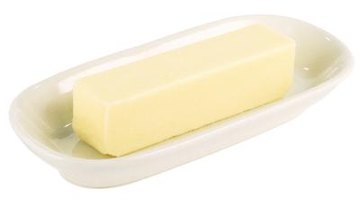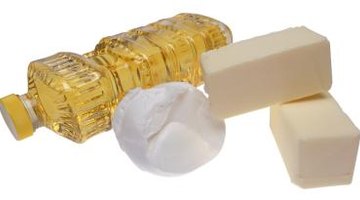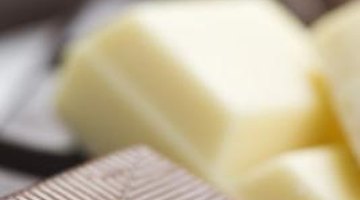Fondant can either be used to create a smooth covering for a cake or as a creamy centre for chocolate-covered candy. Fondant has to be pliable and easily rolled and moulded, and also capable of retaining its shape and consistency at room temperature. Fondant also must have a neutral flavour that won't clash with that of the cake as well as a mouth-feel that is enjoyable. These characteristics are affected by the type of shortening used in the recipe.
Butter or Margarine

Butter is made from cream that is whipped or churned into a solid. Butter has a distinct, sweet, creamy flavour; its colour ranges from light yellow to bright yellow. Margarine is a vegetable oil blend into which milk solids and colourants have been added. It is manufactured to emulate butter.
Both butter and margarine have low melting points. Fondant made with butter or margarine tends to be unstable; the heat of the confectioner's hands during moulding will soften the product to the point where it may not hold it shape. Butter is also highly perishable when not refrigerated, and exposure to air and light hastens rancidity. For these reasons, neither butter nor margarine are recommended for making fondant.
- Butter is made from cream that is whipped or churned into a solid.
- For these reasons, neither butter nor margarine are recommended for making fondant.
Hydrogenated Vegetable Shortening

Hydrogenated vegetable oil is a solid, colourless blend of vegetable oils to which hydrogen has been added. Some of these products are blended with rendered animal fats -- lard -- as well. Hydrogenated vegetable oil has a much higher melting point that either butter or margarine, generally around 43.3 degrees Celsius.
Hydrogenated vegetable oil has a soft, creamy texture that allows it to incorporate sugar and other inclusions well. Fondant made with this product is bright white, holds up well when rolled or shaped by hand, and won't develop off-flavours when not refrigerated. Because the oil itself is flavourless, the other ingredients will flavour the fondant.
- Hydrogenated vegetable oil is a solid, colourless blend of vegetable oils to which hydrogen has been added.
- Hydrogenated vegetable oil has a soft, creamy texture that allows it to incorporate sugar and other inclusions well.
The two most widely published fondant recipes recommend using hydrogenated vegetable oil. It is relatively inexpensive and widely available.
One drawback of using hydrogenated vegetable oil in fondant is its high melting point. Because this shortening melts at a temperature higher than that of the body, the fondant may leave an oily sensation in the mouth.
Lard

Lard is produced from animal fats that have been rendered and bleached. Modern lard has many of the cooking attributes of hydrogenated vegetable oil: it is colourless, fairly odourless and has a melting point that is higher than that of butter or margarine but lower than that of hydrogenated vegetable oil. Lard is the preferred fat for use in baking pies and pastries.
- Lard is produced from animal fats that have been rendered and bleached.
- Modern lard has many of the cooking attributes of hydrogenated vegetable oil: it is colourless, fairly odourless and has a melting point that is higher than that of butter or margarine but lower than that of hydrogenated vegetable oil.
Lard tends to be translucent rather than opaque. This produces a fondant that has more of a grey tint rather than the pure white produced when using hydrogenated vegetable oil. Some people also report the presence of a faint "meaty" taste when lard was used in icing and fondant. Lard is a little more expensive than hydrogenated vegetable oil, but is also readily available in most grocery stores.
Cocoa Butter

Cocoa butter is extracted from cocoa beans during the manufacture of cocoa powder. It is an ivory coloured, silky solid that hints of chocolate in its flavour and fragrance. Cocoa butter melts at a temperature of 35 degrees Celsius, making it the optimal shortening to use in candies and confectionery that strive for a "melt-in-the-mouth" texture. Cocoa butter remains solid at room temperature, so fondant made with this shortening stays pliant and cohesive while it is being worked and holds its shape at room temperature.
- Cocoa butter is extracted from cocoa beans during the manufacture of cocoa powder.
- Cocoa butter melts at a temperature of 35 degrees Celsius, making it the optimal shortening to use in candies and confectionery that strive for a "melt-in-the-mouth" texture.
There are three drawbacks to using cocoa butter. First, cocoa butter triggers allergic reactions in people with sensitivity to chocolate. Second, cocoa butter needs to be ordered through speciality distributors that offer baking or confectionery supplies. Third, cocoa butter is extremely expensive; at retail, cocoa butter is nearly eight times the price of butter. Although cocoa butter makes excellent quality fondant, the cost, availability and allergenic properties of the ingredient prohibit its widespread use.
